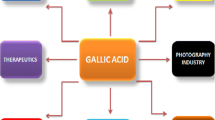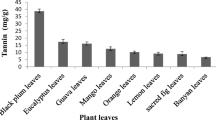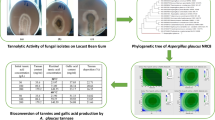Caesalpinia digyna, a tannin-rich forest residue, was used as substrate for production of tannase and gallic acid. Media engineering was carried out under solid-state fermentation, submerged fermentation and modified solid state fermentation conditions for optimum synthesis of tannase and gallic acid (based on 58% tannin content in the raw material). Tannase vis-à-vis gallic acid recovery under modified solid-state fermentation condition was maximum. Conversions of tannin to gallic acid under solid-state fermentation, submerged fermentation and modified solid-state fermentation conditions were 30.5%, 27.5% and 90.9%, respectively. Journal of Industrial Microbiology & Biotechnology (2000) 25, 29–38.
Similar content being viewed by others

Author information
Authors and Affiliations
Additional information
Received 02 November 1999/ Accepted in revised form 12 February 2000
Rights and permissions
About this article
Cite this article
Kar, B., Banerjee, R. Biosynthesis of tannin acyl hydrolase from tannin-rich forest residue under different fermentation conditions. J Ind Microbiol Biotech 25, 29–38 (2000). https://doi.org/10.1038/sj.jim.7000011
Issue Date:
DOI: https://doi.org/10.1038/sj.jim.7000011



